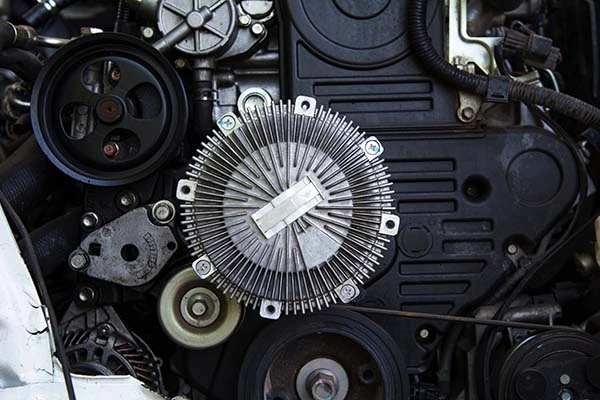The unsung hero of the car’s cooling system is the fan clutch. Without it, the engine would overheat and render itself useless in days, if not less. Any car owner should pay more attention to this component, including learning how to tell if a fan clutch is bad. When you know this, you’ll know its value and worth.
What Is a Fan Clutch?
A fan clutch is temperature-controlled and connects the water pump shaft with the fan. Because of that, the fan becomes a kind of cooler for the engine. This is because it engages and disperses coolant to prevent overheating with constant airflow.
In the same way, the fan clutch can freewheel at lower temperatures because its cooling functions aren’t needed; this is when the engine heats up naturally. However, when the car speeds up, the engine picks up more heat, and the fan clutch gets activated to disperse the cool air and prevent the engine from overheating.
It’s not exactly like the clutch master cylinder or fixing a bad car thermostat, but it’s a vital point of your four-wheeler. The more you know about it, you’ll be more familiar with the car’s functioning. That way, when you sense that your vehicle may be overheating, checking the fan clutch should be high on your list.
How Does It Work?
The majority of fan clutches use silicone-based oil to aid their proper functioning. The component has an internal reservoir to which the oil is added; this is also where it sits while the fan clutch is turned off.
When the car temperature requires this component to engage, the internal valves open up and let the oil (or fluid) fill its working area. This allows the fan to spin without any friction. Essentially, the oil in the fan clutch is lubing the gears, so it doesn’t get stuck.
When it disengages, the valves close and the fluid remains in the reservoir. This helps the fan spin independently from the shaft, staying in a sort of freewheeling state.

The Three Types of Fan Clutches
Three types of fan clutches could be installed in various cars – non-thermal, thermal, and electronic. All three are silicone-based, but they function quite differently. Thermal fan clutches also have subcategories, typically installed in racing cars that reach high speeds and temperatures in a short time.
Non-Thermal Clutches
These types of fan clutches are rpm-dependent. For example, at low rpm, the valves open and allow the fluid to flow out and engage the fan. At high rpm, the centrifugal force increases in accordance.
That centrifugal force also pushes the fluid against the valves, closes them, and keeps the oil in the reservoir. When the valves are closed, the fan disengages, although not completely – it’s always operational for at least a little bit.
Thermal Clutches
The thermal clutch responds to underhood temperatures; its functioning depends on a bi-metallic spring that senses the temperature. When the engine cools off, the fan disengages; when it heats up, the bi-metallic spring rotates the valve plate, hinting to the fluid that it’s time to go.
Thermal fan clutches have three levels:
- Standard Duty – these turn the fan at 50% – 60% of the water pump speed when engaged,
- Heavy Duty – these turn the fan at 80% – 90% of the water pump speed, thus providing more air for better cooling,
- Severe Duty – similar to heavy-duty ones, these clutches turn the fan at 80% – 90% of the water pump speed but possess a larger working area. This allows them to cool faster and last longer.
Electronic Clutches
Electronic fan clutches operate the same way as thermal ones, except the valves are controlled by the vehicle’s computer. The computer sends an ECM or PCM signal to the clutch valves, controlling their levels of engagement.
The fan speed is dictated by the cooling levels required, which can be hinted at with certain variables. The variables that impact the ECM or PCM signals include:
- The coolant temperature,
- Intake manifold temperature,
- Transmission oil temperature,
- A/C pressure,
- Engine oil temperature.
Be mindful of the fact that the fan on the fan clutch is never actually completely disengaged. Even when off, it turns at around 20% – 30% of the water pump speed.

What Are the Main Components of a Fan Clutch?
As mentioned above, fan clutches use silicone-based oils. They’re rather complex components with several different parts. The main parts include:
- Valve plates,
- Valve shaft,
- Valve gate,
- Drive plate,
- Return channel,
- Thermal spring,
- Reservoir,
- Land & grooves.
What Happens if This Component Goes Bad?
If the fan clutch goes bad, many things can go wrong in the car. It’s different from changing a flat tire; the car will stop in both cases, but with fan clutches, other stuff can go wrong, too.
A faulty fan clutch can also cause problems with the A/C, engine functioning, and multiple temperature controls within the vehicle. You can replace the part on your own (just like you can replace a valve stem) or take the car to a mechanic for more efficient and professional work.

How to Tell if a Fan Clutch Is Bad – The Warning Signs
When a fan clutch is failing, it’s important to recognize the warning signs. There are plenty of ways to tell something’s wrong before your car comes to a screeching halt in the middle of nowhere.
Here’s how to recognize that your fan clutch has worn off:
- The car overheats – it’s easy to recognize this symptom, but many people ignore the fan clutch as a potential cause. If you notice your car’s temperature rising the longer you drive, ensure you check the fan clutch,
- The fan is loose – a failing fan clutch may display a wobbly fan, but you don’t have to open your hood to look at it all the time. If you hear clanking while driving at high speeds (such as on the freeway,) stop and check out your engine,
- Acceleration and power decrease – if the fan clutch doesn’t work as well as it should, the engine won’t either. As a result, this can cause a decrease in the engine’s (and the car’s) overall performance,
- Dropped fuel efficiency – just like acceleration and power, a faulty fan clutch can take away from the car’s fuel efficiency. When it affects the engine, there can be unnecessary and excessive drag,
- Extremely loud cooling fans – when you accelerate your car’s speed, the fan engages; if the fan is very loud when you speed up, this could be a sign of a faulty fan clutch. Sometimes, the noise can be present even during a drop in acceleration, considering the fan clutch is always operational.
These are the major signs that show something’s wrong. However, there are smaller warning signs that should still warrant a checkup. They include:
- The fan spins excessively while the engine is at a halt,
- Bad A/C performance at lower speeds,
- The fan blades move more than a quarter of an inch when wiggled front to back,
- Vibrating car,
- Leaking fluid and oil buildup around the thermal spring,
- The fan doesn’t accelerate unless the engine is overheating.
The Steps for Checking the Fan Clutch
As mentioned, the fan clutch is in charge of reducing the engine heat and making sure that the car doesn’t overheat generally. Despite that, some temperature rises are good – that increases performance, fuel vaporization and economy, and the function of the A/C system.
However, excess heat is bad for the engine as it can become irreparably damaged. That’s why the fan clutch is there. Strange noises, vibrations, and too much heat coming from the car are all signs of overheating and potentially a faulty fan clutch.
Spin and Wiggle the Fan
You can check it by spinning the fan on your own; while the engine’s off, try to spin it. If the fan is too loose, it’ll rotate more than three times and likely be faulty. If it doesn’t spin, there may be issues with the bearing.
Besides spinning the fan, trying to wiggle it is a good idea, too. Moving it backward and forward can help you learn if it’s loose. If it is, the fan will move around a quarter of an inch in both directions. That could indicate a bearing problem or a faulty fan.
Check for Leaks
Checking for leaks is another efficient way to learn more about your fan clutch function. Since this component holds fluid inside its center, it’s full of oil. However, the oil shouldn’t be leaking; if it does, that could be a quick ticket to the mechanic.
Finally, if you have an electronic fan, you can buy a scan tool to help you understand it. There are plenty of scan tools and electronic diagnostic devices available for purchase, and every car owner should know how to use one. Sometimes this may be the only way to diagnose a faulty electronic fan clutch.

Is It Possible to Fix it Alone?
As with anything else on cars, a fan clutch is possible to fix on your own. What’s required of you is at least some knowledge of this component and how it works. You should also know the clutch type and the easiest way to diagnose its faultiness.
If you have some basic knowledge of fan clutches, following the instructions for checking for a bad one isn’t complicated. If your car has one of any of the listed problems, it’s recommended to check the engine and the fan clutch.
Since this could take longer than anticipated, you may be better off sending your car to a mechanic. Before you do, it’s wise to learn about the possible issues that manifest with similar symptoms, just in case.

To Keep Your Car Running Properly, Take It to a Mechanic
Fan clutches are crucial components in cars. Without them, vehicles may not be able to cross even a mile, let alone avoid overheating. Despite the engine needing heat to run efficiently, it can combust at extremely high temperatures – which is why there’s a fan clutch to stop that from happening.
If you learn how to recognize warning signs soon and check for faulty fan clutches, you’ll prevent a massive disaster. It’s not like changing winter and summer tires – it’s more complex and crucial. Besides, taking care of your four-wheeler is vital in every aspect. If you don’t, you might as well be throwing money down a drain.








